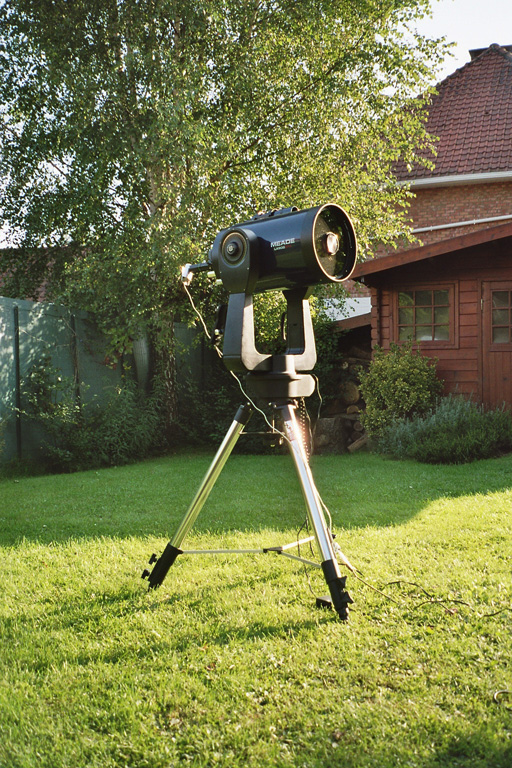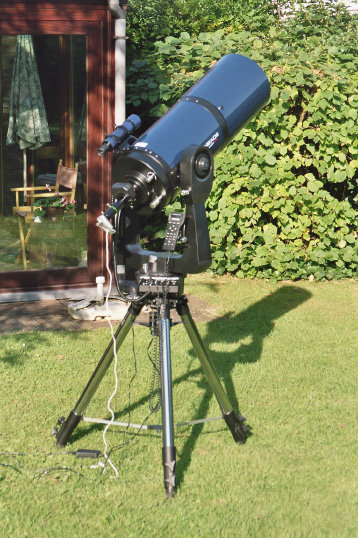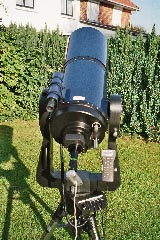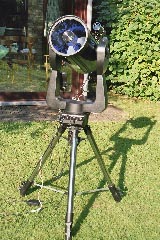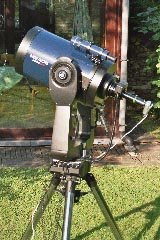I purchased a Meade LX200 10 inch telescope in January 2005. Its large diameter is very convenient for observing the deep sky. Many galaxies can be observed with a telescope within such an aperture. However, do not expect to see the spiral structure of the galaxies like you would see in photos! At most, a few subtle details are visible through the eyepiece in the telescope.
e.g. The galaxy M82 appears elongated as a cigar, while its neighbor takes the form of a big blur. On M51 - the Great Galaxy of the Hunting Dogs - the spiral structure reveals itself under a sky of good quality. Of course, the weakest extensions do not appear on visual observations, but the galaxy shows us enough to let us dream.
The focal length of the telescope is 2.5 meters and the apparent field of view is therefore quite narrow. It is impossible to see the Great Andromeda Galaxy, the Pleiades or the double cluster in Perseus whole in the field of the eyepiece. However, these objects are beautiful in the eyepiece, even if we must move the telescope to see the whole structure.
The field of investigation of the telescope can be found elsewhere: in the research of the many small galaxies bursting in the sky, and in the discovery of planetary nebulae and star clusters. What enjoyment it is to observe distant galaxies! In the case of the planetary nebulae, the most remarkable with this scope are without doubt the Ring Nebula (M57), but also the Dumbbell Nebula (M27).The Orion Nebula (M42) does not fall entirely within the scope of a wide field eyepiece and it is necessary to move the telescope to observe M42 in its glory. This nebula is remarkable! In winter, I am often left hanging at the eyepiece by -10°C to observe it because it was so impressive. This is undoubtedly the first object of the deep sky to watch when you have a telescope.
Anyway, don't particularly miss the "Great Red Spot" on Jupiter, a large storm that may be twice the size of the Earth. The movement of satellites around the planet are also interesting to observe.
I remember one evening when I had just put out my telescope. After setting the telescope in station, I looked at Jupiter and I saw the shadow of one of its satellites drawing on the planet. You'll probably tell me yes, and so what? It was the first time I saw that and I was quite excited at the idea of being able to photograph the event. I quickly mounted the web-cam and I managed to capture this rare phenomenon.
The Meade LX200 is, in my opinion, an excellent choice, providing that you know his advantages and disadvantages. That telescope presents a very good price for money ratio. If you can find a telescope SC 10" with an equatorial mount suited for imaging at a price lower than the LX200, do not hesitate to let it me know. For a ten inch telescope, we must have a mount like a Losmandy G11 or another mount of this kind. Evaluate the total costs and you will come to an exorbitant amount unlike that of the cost for a Meade LX200 10".
Another approach is to buy a good equatorial mount from the beginning to make imaging a future pursuit. The budget allocated to the mount probably won't let you invest in a large tube telescope, but it will give you the freedom to change your equipment in the future. Thus, with a small refractor (for example an Orion 80ED), you will discover the most widely objects of our close universe, benefiting from a large field of view. The planets will be very small, but it's already possible to make very beautiful observations. The moon is beautiful in a refractor and is visible in its entirety (not with my telescope and my eyepieces, unfortunately). Later, when you will have more money to dedicate to astronomy, you can always invest in telescope tube to observe our universe in optimal conditions. At the time of purchasing the LX200, I was a little bit disappointed by apparent complexity of the equatorial mounts. Moreover, I could not accept the prohibitive cost of these mounts and I wanted to discover the sky in its glory immediately; I had only a small refractor from a department store. I didn't want to wait many years to get the necessary budget in order to buy a scope like the 10" Schmidt-Cassegrain which would land on an quality equatorial mount.
I do not regret my purchase. I'm well aware that if I want to change instruments, I have to sell it as a whole package, that's the main disadvantage of the LX200 fork mounted telescopes compared to the equatorial mounts. Anyway, it takes years before being able to operate the telescope at 100%.
The LX200 is heavy, I say frankly, it's not easy to transport and mount it when you are alone. The model 8" is certainly more portable. I seriously don't consider bringing the 12 inch model when by myself. Its weight makes it very stable, and the alt azimuthal configuration reinforces this stability (equatorial mounts not well balanced with some counterweights are very unstable).
Click on photo for larger view
Initializing the telescope is very simple, the LX200 compensates itself for the ground's lack of levelness on which it is placed. It locates its position thanks to it's GPS, then it searches and turns itself towards 2 bright reference stars which need only to be centered to achieve perfect alignment.
In most cases, my telescope is used in alt-azimuth mode and I do not encounter any major problems with this configuration. The planets move a little bit on the sensor of the camera but it's not annoying. Often, I have myself move them with the hand-box in order to avoid dusts from falling onto the sensor of my camera.
The accuracy of the Goto is very impressive. After a first calibration of the telescope's sensors(encoders) and a train of the drives (Setup menu>"Calibrate Sensors" and "Train drives"), searched objects are centered in the eyepiece, even at 300X magnification. If your passion is the photography of the deep sky, you can just select a star near your favorite galaxy with your hand-box and press the "Enter key" 2 seconds to perfect the alignment of the star in the eyepiece before pressing "Enter" again so that the telescope can record its positioning errors. Then you will can select the galaxy and you can be sure that it will move to the object and center it perfectly on the sensor of your web-cam, ccd or digital camera.
The LX200 can be driven remotely via proper cables. The computer system of the telescope can also be updated by logging on Meade's website (see the "Technical" category of my website to learn how you can do that).
If you are photographing with this type of telescope, be aware that you'll be forced to limit the length of your exposures to 2 minutes in order to avoid the field rotation effect which is inherent with alt-azimuth mounts and being too visible on the images. This rotation of field can nevertheless be corrected by computer, by rotating each frame of the image to the correct angle (determined by a small software). It's common use, but less precise than the results obtained while using an equatorial mount. On the other hand, an equatorial mount being initialized with poor accuracy will also present a rotation of field. All of my pictures of the planets have been taken with the LX200 in alt-azimuth mode.
I have not yet seriously invested any time in the deep sky astrophotography. I know, however, several things on this subject. The telescope, in alt-azimuth mode, suffers with the field rotation which appears in long exposure photography. To address this problem, it is necessary to buy an equatorial table / wedge. It's an expensive accessory but it's very practical; the telescope, with the fork mount on an equatorial wedge, behaves similar to a true equatorial mount.
To use the LX200 with the equatorial table/wedge, it is necessary to follow a rigorous approach. We must place the basis of the equatorial table in an horizontal configuration with the help of a bull level by adjusting the length of the telescope's feet. Then we adjust the tilt of the oblique shelf so that the fork points north toward the Polar star with the help of your viewfinder (OTA aligned to +90°). A more accurate up-to station by the King method or Bigourdan helps to refine the alignment in azimuth and inclination of the equatorial table. This is essential for long exposure photography.
Meade has just released the LX200ACF which is more expensive than the LX200 GPS. This new type of telescope simply adopted another optical design (Ritchey-Chretien instead of Schmidt-Cassegrain), optimized for imaging. On a SC (Schmidt-Cassegrain), several optical defects appear in photography, when we move away from the center of the photographic field. Stars appear elongated on the board of the picture. The solution is to get a focal reducer/field flattener. The Ritchey-Chretien has a field plan, but it is less suited to visual observation because of its imposing secondary mirror on the closure glass.
If you want to photograph the heavens, either to image planets or the deep sky, you will need several accessories. Think about it because it inflates the budget.
